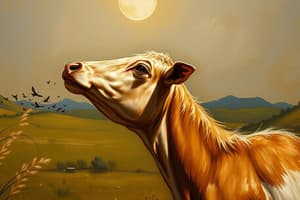Podcast
Questions and Answers
What is the estimated annual cost of flystrike to the Australian sheep industry?
What is the estimated annual cost of flystrike to the Australian sheep industry?
$280 million
Identify the two most prevalent types of flystrike in sheep.
Identify the two most prevalent types of flystrike in sheep.
Body strike and breech strike
What environmental factors influence the risk of flystrike?
What environmental factors influence the risk of flystrike?
Environmental conditions and sheep susceptibility
Which species of fly is responsible for about 90% of all flystrikes in sheep?
Which species of fly is responsible for about 90% of all flystrikes in sheep?
Describe the appearance of the Australian sheep blowfly.
Describe the appearance of the Australian sheep blowfly.
What role does the hairy maggot fly (Chrysomya rufifacies) play in relation to flystrike?
What role does the hairy maggot fly (Chrysomya rufifacies) play in relation to flystrike?
What are the consequences of untreated flystrike for sheep?
What are the consequences of untreated flystrike for sheep?
How can predicting blowfly larvae development assist in managing flystrike risk?
How can predicting blowfly larvae development assist in managing flystrike risk?
What is the average lifespan of an adult fly?
What is the average lifespan of an adult fly?
How long does it take for eggs to hatch into larvae?
How long does it take for eggs to hatch into larvae?
What temperature range is ideal for the occurrence of flystrike?
What temperature range is ideal for the occurrence of flystrike?
Why does the female fly need a protein feed after hatching?
Why does the female fly need a protein feed after hatching?
What crucial environmental condition must exist for flystrike to occur regarding moisture?
What crucial environmental condition must exist for flystrike to occur regarding moisture?
What is the maximum distance adult flies typically travel from their hatching site?
What is the maximum distance adult flies typically travel from their hatching site?
How quickly do larvae grow after hatching?
How quickly do larvae grow after hatching?
What environmental factor related to wind speed is ideal for fly dispersion?
What environmental factor related to wind speed is ideal for fly dispersion?
Flashcards are hidden until you start studying
Study Notes
Overview of Flystrike
- Flystrike in sheep poses a serious health and welfare risk, costing Australia approximately $280 million annually.
- Active monitoring and management are vital to preventing productivity losses and ensuring animal welfare.
Economic Impact
- Flystrike directly affects enterprise profitability through decreased animal productivity and increased treatment costs.
- Effective management reduces health risks for sheep and enhances farm business productivity.
Types of Flystrike
- Five types of flystrike exist, with body and breech strike being the most common and significant.
- The prevalence of flystrike types is influenced by environmental conditions and sheep susceptibility.
Predicting Flystrike Risk
- Assessing flystrike risk involves understanding environmental conditions and the susceptibility of sheep.
- Knowledge of the biology and lifecycle of the Australian blowfly (Lucilia cuprina) is essential for effective prediction.
Biology of the Australian Sheep Blowfly
- L.cuprina accounts for about 90% of flystrikes; it is copper green with reddish eyes and approximately 10mm long.
- The smooth-skinned white maggot of L.cuprina results from adult flies, which typically live for two to three weeks.
- Eggs hatch into larvae within 12-24 hours, growing from pinhead size to 10-15mm in about three days before dropping off to pupate.
Lifecycle and Behavior
- The complete lifecycle of L.cuprina ranges around 17 days in warm weather.
- Adult blowflies generally do not travel more than three kilometers from their hatching site.
- Female flies require protein sources (from carcasses, manure, and existing strikes) for reproductive maturity and egg-laying.
Environmental Conditions Favoring Flystrike
- Key conditions include the presence of primary species (Australian sheep blowfly), adequate temperatures (15–38 degrees Celsius), and recent rainfall to keep sheep moist.
- Wrinkles, urine, and feces on sheep provide suitable sites for fly attraction and larval sustenance.
- Low wind speeds (below 9 km/h) facilitate better dispersal opportunities for flies.
Strike Incidence Insights
- Flystrike occurrence can be significant even with low blowfly populations; a historical example shows a 62% strike rate at Mount Barker Research Station with minimal fly catch in traps.
- Monitoring the abundance of L.cuprina is crucial to understanding potential strike risks.
Studying That Suits You
Use AI to generate personalized quizzes and flashcards to suit your learning preferences.



